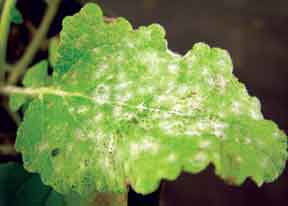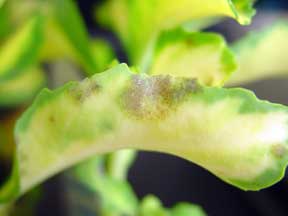Scouting in herbaceous perennials: Powdery mildew
Pathogen: Multiple including Erysiphe spp., and Microsphaera spp.
Hosts: Achillea, Aquilegia, Aster, Coreopsis, Clematis,
Delphinium, Helianthus, Lupinus, Monarda, Phlox, Pulmonaria, Rudbeckia,
Salvia, Scabiosa, Solidago, Sedum, Veronica and Viola.
Symptoms: White, talcumlike colonies on the leaf surface.
Chlorotic spots may be present on the leaf surface opposite the colony.
Under favorable conditions, colonies enlarge and coalesce, blighting
larger sections of foliage. Severe infections on some hosts cause
defoliation. Infection on sedum causes slightly raised scabby lesions;
powdery colonies may not be readily visible.
Spread: Powdery mildew spores are air-disseminated and subsequently infect leaves and stems of plants under humid conditions.
Management: Scout plantings for signs of disease. Timely
fungicide applications made early in the disease epidemic are more
effective at control. Reduce the relative humidity, if possible – high
levels are conducive to powdery mildew development. Increase plant
spacing to promote air movement around plants. Fungicide applications
may be necessary. Use both systemic and protectant products. Powdery
mildew fungi can develop resistance to systemic fungicides. To delay the
development of fungicide resistance, these products should not be used
exclusively.
Note: Although many plants are affected by powdery mildew, each
powdery mildew fungus has a specific host range, usually affecting
closely related plants. For example, Phlox infected with powdery mildew
will not serve as a source of inoculum infecting Aquilegia.
Editor’s note: This and more disease identification information is available in the filed guide A Pocket Guide for IPM Scouting in Herbaceous Perennials To order call 517-353-6740.



 Print
Print Email
Email






